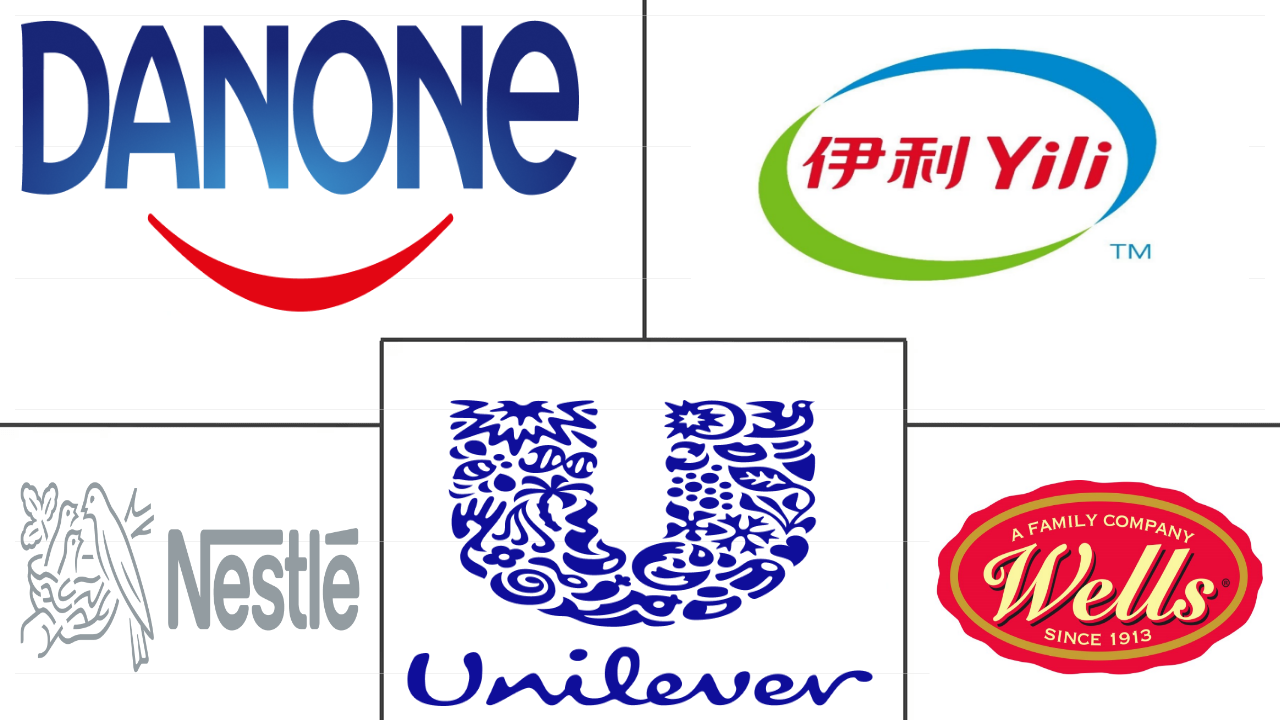Market Size of dairy desserts Industry
| Icons | Lable | Value |
|---|---|---|
|
|
Study Period | 2017 - 2029 |
|
|
Market Size (2024) | USD 108.9 Billion |
|
|
Market Size (2029) | USD 131.2 Billion |
|
|
Largest Share by Distribution Channel | Off-Trade |
|
|
CAGR (2024 - 2029) | 3.80 % |
|
|
Largest Share by Region | Europe |
|
|
Market Concentration | Low |
Major Players |
||

|
||
|
*Disclaimer: Major Players sorted in no particular order |
Dairy Desserts Market Analysis
The Dairy Desserts Market size is estimated at 108.9 billion USD in 2024, and is expected to reach 131.2 billion USD by 2029, growing at a CAGR of 3.80% during the forecast period (2024-2029).
108.9 Billion
Market Size in 2024 (USD)
131.2 Billion
Market Size in 2029 (USD)
2.48 %
CAGR (2017-2023)
3.80 %
CAGR (2024-2029)
Largest Market by Product Type
90.87 %
value share, Ice Cream, 2023
The increasing adoptibility of ice cream consumption in all the seasons with adoption of various twisted sophisticated flavours is largely driving the segmental growth.
Largest Market by Distribution Channel
87.82 %
value share, Off-Trade, 2023
The product assortment and shelf space in off-trade retail channels is allowing consumers to compare the products, which has emerged to be one of the major factor driving segmental growth.
Fastest-growing Market by Product Type
3.72 %
Projected CAGR, Ice Cream, 2024-2029
The country's taste for ice cream is anticipated by the ongoing market compliance with the existence of numerous retailers with the emergence of different exotic flavours.
Fastest-growing Market by Distribution Channel
3.83 %
Projected CAGR, Off-Trade, 2024-2029
The ongoing demand in off-trade channels majorly through online distribution channel as it provides ease of shopping with ample option availability is inticing the growth of segment.
Leading Market Player
14.65 %
market share, Unilever Plc, 2022

Unilever Group gained a competitive edge over other players due to its extensive product portfolio with wider brand presence, along with its strategic moves toward innovation.
The sales through off-trade distribution channels with the presence of wider product range is making the market
- The off-trade segment dominates among distribution channels of the global dairy desserts market. In the off-trade segment, consumers prefer buying dairy desserts majorly from supermarkets and hypermarkets, as this channel often offers competitive prices on dairy desserts, especially when compared to specialty stores or boutique shops. This is because these outlets can purchase dairy desserts in bulk and pass on the savings to consumers. Hypermarkets and supermarkets usually offer a wide range of brands and products of dairy desserts, giving consumers a variety of options to choose from. This allows consumers to compare different brands and products and make informed purchasing decisions.
- Convenience stores account for the second highest share in the sales of dairy desserts, after supermarkets and hypermarkets. In 2022, the sales value of dairy desserts through convenience stores increased by 3.5% over the previous year.
- Dairy desserts are commonly offered through restaurants and food service channels. Foodservice channels offer various dairy desserts, including unique and customized options, which attract customers looking for something different or personalized. The sale of dairy desserts in restaurants and other food service channels is driven by various factors, including menu offerings, variety and customization, convenience and speed, quality and freshness, and presentation and atmosphere. Dairy dessert sales through the on-trade channel are anticipated to grow by 11.4% in 2025 compared to 2022. About 47% of consumers across the globe consumed meals at restaurants, and 31% of consumers ordered from foodservice channels in 2022.
The demand from Europe followed by North America and Asia-Pacific drives the global market
- The Y-o-Y growth rate of the global dairy desserts market was 4.1% in 2022 compared to the previous year. Of all the regions, Europe accounted for most of the share of the global dairy desserts market, i.e., 40.4%. Dairy desserts have gained immense traction across the region due to their various health benefits, easy accessibility, and the availability of premium ice creams.
- Ice cream accounts for most of the sales of dairy desserts in Europe. In 2021, the European Union produced over 3.1 billion liters of ice cream, a 4% increase compared to the previous year. Germany, the United Kingdom, and Italy are the key markets for dairy desserts in Europe, collectively accounting for 41.01% of the overall ice cream consumption in the region.
- North America is the second-largest market for dairy desserts. The sales value of dairy desserts in North America registered a growth rate of 6% from 2019 to 2022. The dairy desserts market in North American countries is expanding due to strong demand for ice cream. The average American consumes approximately 23 pounds of ice cream and other frozen desserts per year. About 73% of people consume ice cream at least once per week, and 2 out of 3 consume ice cream in the evening.
- Asia-Pacific is the fastest-growing region in terms of the sales of dairy desserts globally. The sales value of dairy desserts in Asia-Pacific is anticipated to grow by 12.1% in 2025 compared to 2022. New Zealand leads the world in ice cream consumption, with a per capita consumption of 28.4 liters per year. Increasing demand for sweet treats and increased income are the major factors driving the dairy desserts market in the region.
Dairy Desserts Industry Segmentation
Cheesecakes, Frozen Desserts, Ice Cream, Mousses, Others are covered as segments by Product Type. Off-Trade, On-Trade are covered as segments by Distribution Channel. Africa, Asia-Pacific, Europe, Middle East, North America, South America are covered as segments by Region.
- The off-trade segment dominates among distribution channels of the global dairy desserts market. In the off-trade segment, consumers prefer buying dairy desserts majorly from supermarkets and hypermarkets, as this channel often offers competitive prices on dairy desserts, especially when compared to specialty stores or boutique shops. This is because these outlets can purchase dairy desserts in bulk and pass on the savings to consumers. Hypermarkets and supermarkets usually offer a wide range of brands and products of dairy desserts, giving consumers a variety of options to choose from. This allows consumers to compare different brands and products and make informed purchasing decisions.
- Convenience stores account for the second highest share in the sales of dairy desserts, after supermarkets and hypermarkets. In 2022, the sales value of dairy desserts through convenience stores increased by 3.5% over the previous year.
- Dairy desserts are commonly offered through restaurants and food service channels. Foodservice channels offer various dairy desserts, including unique and customized options, which attract customers looking for something different or personalized. The sale of dairy desserts in restaurants and other food service channels is driven by various factors, including menu offerings, variety and customization, convenience and speed, quality and freshness, and presentation and atmosphere. Dairy dessert sales through the on-trade channel are anticipated to grow by 11.4% in 2025 compared to 2022. About 47% of consumers across the globe consumed meals at restaurants, and 31% of consumers ordered from foodservice channels in 2022.
| Product Type | |
| Cheesecakes | |
| Frozen Desserts | |
| Ice Cream | |
| Mousses | |
| Others |
| Distribution Channel | |||||||
| |||||||
| On-Trade |
| Region | ||||||||||||||
| ||||||||||||||
| ||||||||||||||
| ||||||||||||||
| ||||||||||||||
| ||||||||||||||
|
Dairy Desserts Market Size Summary
The dairy desserts market is experiencing steady growth, driven by consumer preferences for convenience and variety. The off-trade segment, particularly supermarkets and hypermarkets, dominates the distribution channels due to their ability to offer competitive pricing and a wide range of product options. Convenience stores also contribute significantly to sales, while food service channels, including restaurants, provide unique and customized dairy dessert options that attract consumers seeking novelty. The market is characterized by a diverse range of products, with ice cream being a major component, especially in regions like Europe and North America, where it enjoys high consumption rates. The demand for innovative flavors and healthier options is shaping consumer choices, with a notable shift towards products that are organic, low in calories, and free from preservatives.
Regionally, Europe holds a significant share of the global dairy desserts market, with countries like Germany, the United Kingdom, and Italy leading in ice cream consumption. North America follows as the second-largest market, driven by strong demand for frozen desserts. The Asia-Pacific region is the fastest-growing market, with increasing consumer expenditure and a rising preference for indulgent yet health-conscious products. The market is fragmented, with major players like Danone, Nestlé, and Unilever holding a substantial share. The introduction of new flavors and products, such as gelato and Isabgol ice cream, reflects the industry's response to evolving consumer tastes and health trends.
Dairy Desserts Market Size - Table of Contents
-
1. MARKET SEGMENTATION (includes market size in Value in USD and Volume, Forecasts up to 2029 and analysis of growth prospects)
-
1.1 Product Type
-
1.1.1 Cheesecakes
-
1.1.2 Frozen Desserts
-
1.1.3 Ice Cream
-
1.1.4 Mousses
-
1.1.5 Others
-
-
1.2 Distribution Channel
-
1.2.1 Off-Trade
-
1.2.1.1 Convenience Stores
-
1.2.1.2 Online Retail
-
1.2.1.3 Specialist Retailers
-
1.2.1.4 Supermarkets and Hypermarkets
-
1.2.1.5 Others (Warehouse clubs, gas stations, etc.)
-
-
1.2.2 On-Trade
-
-
1.3 Region
-
1.3.1 Africa
-
1.3.1.1 By Product Type
-
1.3.1.2 By Distribution Channel
-
1.3.1.3 Egypt
-
1.3.1.4 Nigeria
-
1.3.1.5 South Africa
-
1.3.1.6 Rest of Africa
-
-
1.3.2 Asia-Pacific
-
1.3.2.1 By Product Type
-
1.3.2.2 By Distribution Channel
-
1.3.2.3 Australia
-
1.3.2.4 China
-
1.3.2.5 India
-
1.3.2.6 Indonesia
-
1.3.2.7 Japan
-
1.3.2.8 Malaysia
-
1.3.2.9 New Zealand
-
1.3.2.10 Pakistan
-
1.3.2.11 South Korea
-
1.3.2.12 Rest of Asia Pacific
-
-
1.3.3 Europe
-
1.3.3.1 By Product Type
-
1.3.3.2 By Distribution Channel
-
1.3.3.3 Belgium
-
1.3.3.4 France
-
1.3.3.5 Germany
-
1.3.3.6 Italy
-
1.3.3.7 Netherlands
-
1.3.3.8 Russia
-
1.3.3.9 Spain
-
1.3.3.10 Turkey
-
1.3.3.11 United Kingdom
-
1.3.3.12 Rest of Europe
-
-
1.3.4 Middle East
-
1.3.4.1 By Product Type
-
1.3.4.2 By Distribution Channel
-
1.3.4.3 Bahrain
-
1.3.4.4 Iran
-
1.3.4.5 Kuwait
-
1.3.4.6 Oman
-
1.3.4.7 Qatar
-
1.3.4.8 Saudi Arabia
-
1.3.4.9 United Arab Emirates
-
1.3.4.10 Rest of Middle East
-
-
1.3.5 North America
-
1.3.5.1 By Product Type
-
1.3.5.2 By Distribution Channel
-
1.3.5.3 Canada
-
1.3.5.4 Mexico
-
1.3.5.5 United States
-
1.3.5.6 Rest of North America
-
-
1.3.6 South America
-
1.3.6.1 By Product Type
-
1.3.6.2 By Distribution Channel
-
1.3.6.3 Argentina
-
1.3.6.4 Brazil
-
1.3.6.5 Rest of South America
-
-
-
Dairy Desserts Market Size FAQs
How big is the Global Dairy Desserts Market?
The Global Dairy Desserts Market size is expected to reach USD 108.90 billion in 2024 and grow at a CAGR of 3.80% to reach USD 131.24 billion by 2029.
What is the current Global Dairy Desserts Market size?
In 2024, the Global Dairy Desserts Market size is expected to reach USD 108.90 billion.

